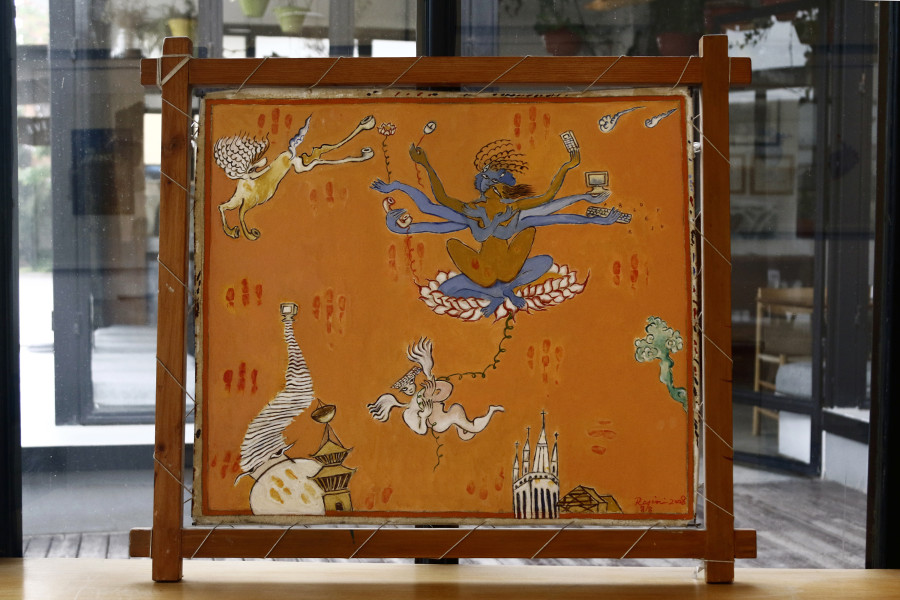Entertainment
Ragini Upadhyay Grela’s new exhibition explores love in the modern age
In an exhibition that brings together old and new paintings, Ragini Upadhyay Grela explores what loves means in the modern age
Timothy Aryal
What would a picture of love look like? “O my Luve is like a red, red rose,” wrote the 18th century Scottish poet Robert Burns. Three centuries now, in artist Ragini Upadhyay Grela’s ongoing exhibition Love Revisited—wherein 17 out of the total 35 pieces have ‘Love’ in their titles—there are only lotuses and hearts, no roses.
Love Revisited is an amalgam of works, some created more than a decade ago—in 2007, 08 and 09—and more recent ones from 2015 and onwards. The difference between the two lots is apparent.
A majority of the earlier works feature nude, half-formed human figures holding appliances such as monitors, mice, keyboards, receivers and cell phones, flying in the air. In some pieces, the human figures are tightly clutching them while in others, they are trying to get a hold of them.
These works feel prophetic. The advent of social media has changed the way romantic partners meet. While previously, there was no way for partners to share their feelings other than by meeting in person, now they have telephones, cellphones and social media. Naturally, this revolutionary development has both pros and cons. And Upadhyay Grela addresses them.
Take, for instance, a piece called ‘Cross Culture’ which at first glance can easily be mistaken for a page from Kamasutra. The focus of the piece is a copulating couple, slightly removed from the centre, sitting on a lotus flower. One of them has multiple heads and hands, spread out in all directions. None of their hands is free; they are holding a monitor, a mouse, a receiver, a cellphone and a keyboard. Curiously, one of the hands is also holding a lotus flower. Surely, the piece represents the havoc computers and other communication devices have wreaked in our lives and our sense of spirit, but the one hand, curiously holding a lotus, makes one wonder how inner peace eludes us in this hyper-connected age.
There are a few other pieces that expand on this theme; in one, a monitor replaces the head of a vague human figure, while in another, an amusing one, the phallus of a horse makes for the arm of a clock.
 Ragini Upadhyay Grela's ongoing exhibition Love Revisited interplays on theme of love and effects of computers and other communication devices in our lives, love and sense of spirit. Post Photo: Keshav Thapa
Ragini Upadhyay Grela's ongoing exhibition Love Revisited interplays on theme of love and effects of computers and other communication devices in our lives, love and sense of spirit. Post Photo: Keshav ThapaThe ‘Love in the Air’ series has pieces that feel, by turns, erotic and grotesque. There are plenty of human figures in various degrees of sexual congress, and in all of these pieces, at least one figure is clutching the thread of a lotus, which is slightly detached from them.
These pieces were created before 2010. In the more recent ones, however, modern computing appliances are surprisingly missing. ‘The Heart’ series features hearts, as implied. These pieces are more crisp and elegant than the earlier, more colourful, ones. Here, the background is all white. In the foreground lie hearts of different shapes, sizes and colours. They are bound by a single red thread. There are peacock feathers, denoting the cycle of time, and clocks. One particular piece features two hearts, the beaks of birds creep out of the pulmonary arteries, looking directly at each other. One of the beaks is holding a flower but the distance between them is wide and the red thread between them looks broken.
This is when the viewer realises that the exhibition takes home the idea of love and all aspects of it—the pain, longing, separation and its evolution through time.
While the exhibit features 35 pieces, they seem too many for the cramped space of the Kathmandu Art Gallery at Le Sherpa. Some of the pieces are located so high on the wall, one has to stretch their head to get a view. And the glass-fenced wall of the room does a disservice to the exhibition, reflecting objects on the opposite side of the pieces. Placing titles on the sides of the paintings would have done no wrong as well. But besides these faults with the use of space, the exhibition makes for a worthy visit—for it invites viewers to mull over love, our technology-infused modern love.
Love Revisited is on show at the Kathmandu Art Gallery in Le Sherpa, Lazmipat, until April 13.




 11.12°C Kathmandu
11.12°C Kathmandu










